Any plant inspired by a Greek goddess is sure to get one’s attention. Hebes are genus of plants native to New Zealand (where it is the largest plant genus), French Polynesia, the Falkland Islands, and South America. It includes about 90 species.
In our guide, we’ve covered everything from growing and caring for a hebe shrub, how to propagate one, and even how to take the perfect cutting.
More...
Genus: | Hebe |
|---|---|
Family: | Plantaginaceae |
Common Name: | Hebe shrub, shrubby Veronica |
Plant type: | Shrub |
Lifespan: | 5 to 10 years |
Size: | 40cm to 1.5m |
Sun requirements: | Full, partial |
Soil Type: | Acidic, neutral, alkaline, well-draining |
Flower Colour: | Green |
Maintenance level: | Low |
Poisonous for pets: | Yes |
Hebes Plant Details
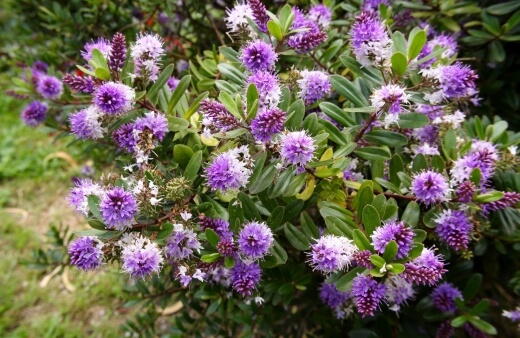
It might be easy to overlook this garden gem but the hebe plant is seriously underrated. This interesting evergreen shrub was named after the Greek goddess of youth. Hebe shrubs are versatile, thriving happily in many conditions and are super easy to maintain.
Some of the benefits of planting hebes are:
- Hebes are compact and low maintenance
- They’re generous with their flowers
- Butterflies find them charming
- The textures and colours of the leaves are interesting all year round
- They look fantastic in a container
- Hebes come in different sizes, many of which are perfect for small gardens.
- They work in any style of garden
Features of a Hebe Shrubs
Hebe shrubs range in size – some are small bushes that may grow to about 1 metre tall, and others are larger tree-like varieties that stand as tall as 2 metres.
There are also both large and small-leafed types. A hebe is evergreen but the foliage delights with additional colours of burgundy and bronze.
Hebes Natural Habitat
Hebes are found in many different habitats but the more common places that you would find them are grassland and on mountain slopes that deal with frost and wind. A few varieties are found in coastal lowland, and an even smaller variety live in forests.
In the wild, the hebe shrub can either be contained to a small area, or can be widespread. It’s obvious then that hebes are naturally found on the mountainsides and by the coasts of New Zealand.
Most hebes bloom in summer and last throughout autumn. Some of the varieties even flower in winter. The flowers look like spikes and come in a range of colours, from white, pink and crimson to blue and purple.
Popular Varieties of Hebes
There are almost 100 different species within the Hebe genus, and just as many cultivar types. It’s a good idea to do some research to help you choose the right type of hebe, one that will work well with your garden conditions and design vision.
Here are some popular options:
Hebe ‘Variegata’
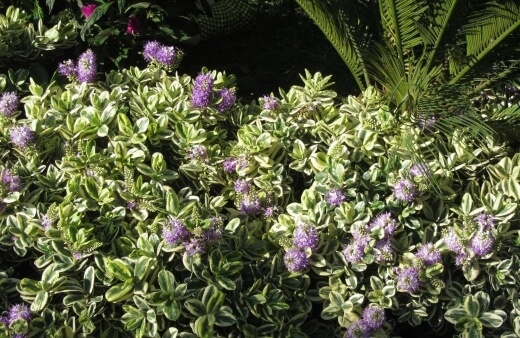
The name kind of gives it away, so yes, it has variegated leaves with a green-grey centre and is cream around the edges.
When the shrub blooms, you will see purple flower spikes appear. This variety of hebe shrub is quite tall, and can reach a height of 1.8 metres.
Hebe ‘Western Hills’
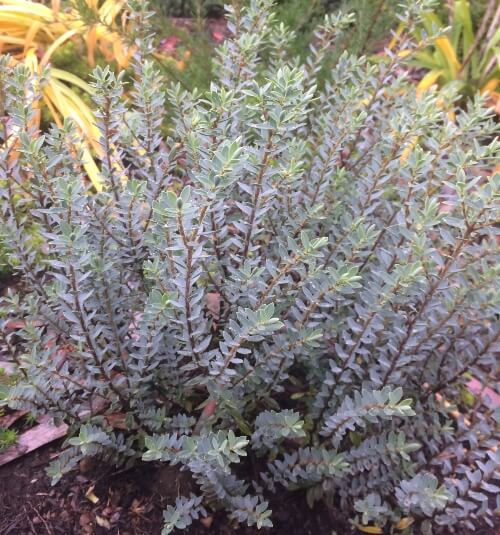
Source: xeraplants.com


Get Your Free Guide:
Master Growing Australian Natives eBook
A Must Have Complete Guide for Every Australian Garden
Get Your Free Guide:
Master Growing Australian Natives eBook
A Must Have Complete Guide for Every Australian Garden
This hebe shrub looks frosty with its combination of silver-grey leaves and bright white or pale lavender flowers.
Hebe ‘Red Edge’
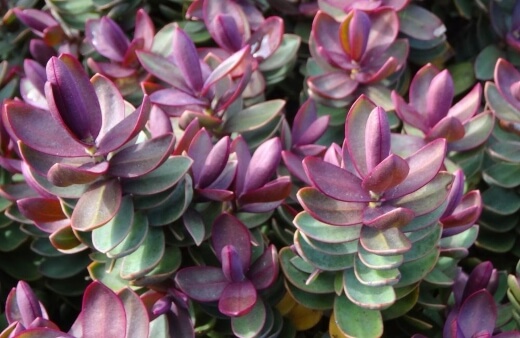
This variety is definitely eye-catching, with its gorgeous silver blue-green leaves. When the flowers appear, the tips of the shrub become shades of red-maroon.
Hebe ‘Grace Kelly’
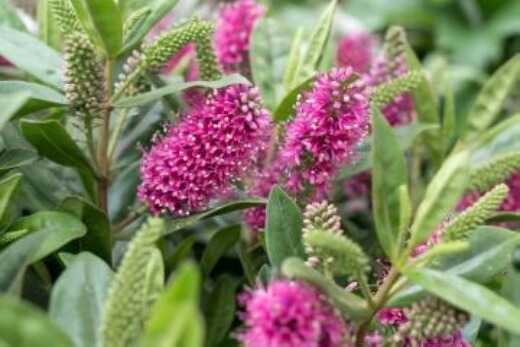
Source: nova.co.at
Always a lady, this variety is famous for showing off variegated white and green leaves, and bright purple flowers when in bloom.
Hebe ‘Variegata’The name kind of gives it away, so yes, it has variegated leaves with a green-grey centre and is cream around the edges. When the shrub blooms, you will see purple flower spikes appear. This variety of hebe shrub is quite tall, and can reach a height of 1.8 metres. |  |
Hebe ‘Western Hills’This hebe shrub looks frosty with its combination of silver-grey leaves and bright white or pale lavender flowers. |  Source: xeraplants.com |
Hebe ‘Red Edge’This variety is definitely eye-catching, with its gorgeous silver blue-green leaves. When the flowers appear, the tips of the shrub become shades of red-maroon. |  |
Hebe ‘Grace Kelly’Always a lady, this variety is famous for showing off variegated white and green leaves, and bright purple flowers when in bloom. |  Source: nova.co.at |
How to Grow Hebes in Australia
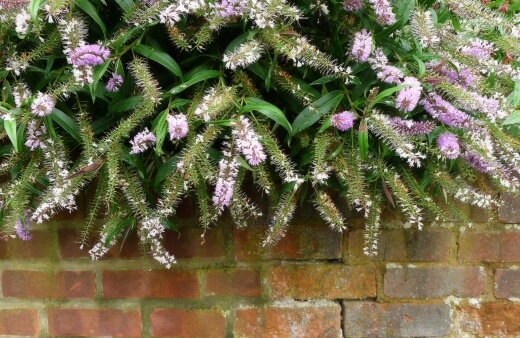
Growing a hebe plant is actually quite easy. They are versatile so you can grow them in different ways. They can be grown as borders, in rock gardens or even in pots. Hebes are ideally suited for areas with cool summers and mild winters.
They adapt to a variety of soil types but first prize is loose, well-draining soil. They can be grown in both sun and shade, but full sun is their favourite.
Young plants should be potted up in spring and planting hebes in the garden should be at the same depth as the container they are growing in. Add compost or organic matter to the soil during planting to help promote healthy growth.
The hebe shrub doesn’t need a lot of care once established. You can apply fertiliser once a year in late winter or early spring before the new growth. Deadheading the dead flowers will promote more flowering, and trimming the plant back about halfway after flowering will promote bushier growth.
Hebes are usually propagated through seeds or semi-hardwood cuttings taken in summer. If you’re in an area with harsh winters, you can protect the shrub by surrounding it with straw mulch.
Propagating Hebes
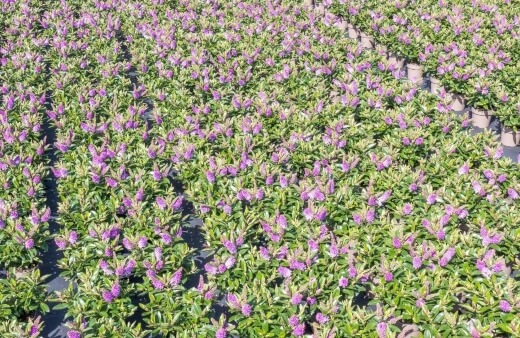
Hebe Propagation from a Cutting
It’s best to grow new hebes from semi-ripe cuttings. Semi-ripe means the cutting should be hard at the base but soft at the tip. You would usually find this type of cutting between the end of summer and in the middle of autumn.
You should only select shoots that are horizontal and they need to have good, short gaps between their leaves.
We’re going to share a basic method which is the easiest and produces good results.
- Step 1. You can start by sanitising your tools. This is an important first step, otherwise the tools can transfer disease to the plant and make it difficult for the new roots to grow. Make sure you disinfect in between each cutting. Another important step before you start, is to sharpen your tools. The sharper your tools are, the easier it will be for you to take one quick cut that avoids more unnecessary cuts to the plant.
- Step 2. Once you have your cutting, you need to pop it in a plastic bag right away and leave it in the fridge or in the shade. Ideally you should plant them in their containers within 12 hours but if you can, take the cutting and plant them straight away.
- Step 3. Prep your cuttings by trimming them to a length of 12cm, cutting just below a leaf node. Once that is done, you can remove any of the lower leaves and the soft tips. As a guideline, there should be about 4 leaves remaining.
- Step 4. Dip the bottom into rooting hormone powder and place the cutting into a good sized container filled with cutting compost. Once the hebe cuttings are in the container, water them well and allow the water to fully drain.
- Step 5. You can now cover each cutting with a plastic bag or plastic container that creates a miniature greenhouse effect. Place them somewhere warm and light, but not in direct sunlight. You will need to remove any extra moisture but be sure to keep the compost damp.
Aftercare
Rooting happens very fast for cuttings taken in the summer. Be sure to remove dead or diseased cuttings when they appear. Let the cutting settle for two or three weeks before you move them outside.
You can place them outside for a few hours on mild days and slowly increase the amount of time that they are outside. This allows them to adjust to the wind and sun.
Once the hebes are established you can transplant them into slightly bigger containers or into their forever home. Sometimes it’s better to transplant them a few times, putting them into slightly larger pots each time, until they are able to be permanently planted.
Propagating Hebe from seed
Though it is possible to grow hebe shrubs from seed, keep in mind that it can take several years for the seedlings to establish and provide flowers.
If you are going to take this route, plant the seeds directly in a container filled with permeable soil. The soil should be moist but not waterlogged. Germination happens in a matter of weeks, but the seedlings grow very slowly.
Perhaps one of your gardening goals is to create a child friendly garden. We’ve got some ideas on how to make it attractive and at a low cost.
Caring for Hebes
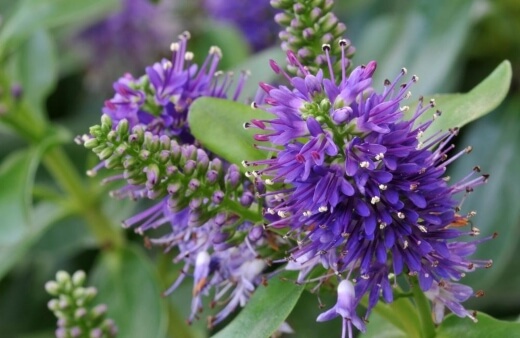
Hebe Light Requirement
Hebe shrubs do best in full sun to partial shade. Too much shade can give them overly long stems and they may stop flowering.
Best Soil for Hebes
Well-draining soil is a must for most hebe shrubs. They like moist soil, but it should never be wet. The hebe doesn’t do well with extremes in soil pH. You should aim for slightly acidic to slightly alkaline soil conditions, but to be safe, neutral soil is generally best.
How to Water Hebes
Hebes are known for being drought tolerant but they still require a good amount of water to maintain their ideal growth and healthy leaves. If you stick to a weekly watering schedule, your hebe will be happy, full, and bright.
Temperature and Humidity
Hebes are hardy and can handle cold temperatures. Heavy frosts could send them over the edge though. The shrubs do best in a climate with warm summers and mild winters.
Fertiliser
Hebes don’t really need fertilising, which again reinforces their easy care. If you want to give your plant a boost, you can add organic matter or compost in late winter or early spring.
If your hebe has lovely leaves but no flowers, it’s probably getting too much nitrogen. Many people use mulch in their garden and then find that the mulch depletes the nitrogen in the soil as it breaks down.
If you have too much nitrogen in the soil, you can use this to your advantage. You can lay mulch over the soil to help draw out some of the excess nitrogen.
Mulch has an incredibly important job when it comes to garden care but do you know when and how to use it? Check out our guide on the best types of mulch for the garden.
Pruning Hebes
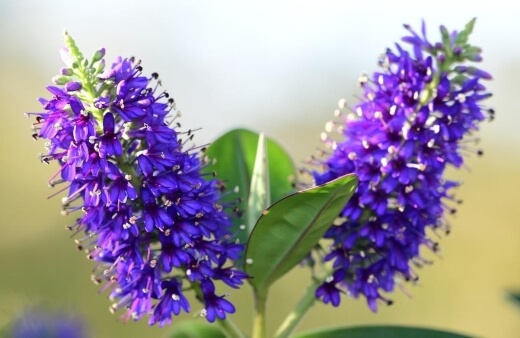
Pruning hebe shrubs is easy and helps keep your plant looking full and beautiful. Once their flowers fade, you can trim them off to encourage more flowers to bloom.
Once the shrub is finished flowering, you can cut it back using the '1/3 Rule' for pruning shrubs to create a bushier look.
The 1/3 rule means cutting about 1/3 of wood during any pruning of a shrub. We find it’s a balanced way to thin out shrubs and stimulate new growth.
The plant will shed quite a few stems in the process, usually on the top, and this allows more light and air to enter the inside of the plant.
During the growing season, you might want to occasionally prune your hebe to help keep the shrub looking its best, but this will also help avoid that overly long stem look (appropriately called ‘leggy’ in appearance).
If a hebe plant is not flowering, you may have removed new growth and nodes during the pruning process. All is not lost though - the hebe will take a season or two to recover and will start flowering again once new growth is fully established.
If you haven't pruned the shrub in years, that can also be the problem. Try and stick to a regular pruning schedule. See our review on the best pruning shears available online.
Potting and Repotting Hebe
Hebe shrubs look great in the garden, but also make lovely potted plants. If they are going to be living in a pot, they can be moved indoors during winter.
Just keep in mind how large the mature hebe is going to be, depending on the variety you’ve chosen. Smaller varieties make the best potted hebes. Choose a pot that is well-draining - hebe shrubs do not like wet soil.
Winter protection
In a warmer climate, established hebe shrubs should be fine during winter. If the climate is cool or the shrubs are young, you can protect them by covering them before the freezing temperatures arrive.
Pests and Diseases that Affect Hebes

Hebes don’t really struggle with pests or diseases. Aphids and spider mites find this plant quite tasty. You can take care of this problem with horticultural oil or an organic insecticide.
Fungal issues can arise if the plant is too wet. Try to keep good air circulation around the shrub and keep the soil moist but not wet. Downy mildew may be a problem in damp areas with poor air circulation.
Septoria leaf spot covers the leaves with brown spots. It won’t kill the shrub, it just makes it less attractive and might sap their energy. Make sure the hebe isn’t crowded by other plants that limit air movement.
Frequently Asked Questions About Hebes
What are good companion plants for a hebe shrub?
Christmas or snow roses look great when planted alongside a hebe shrub.
How long can a hebe shrub live?
With proper care, these shrubs can thrive for up to 10 years.
Where should I place hebe shrubs in my house?
When grown in a pot, hebes still need to experience full sun. Find the sunniest windowsill during the winter months and during the summer, you can take the shrub outside.
Are hebes toxic?
Most hebe species contain toxic chemicals, so keep your shrub away from kids and pets.
Why is one of the common names for Hebe Shrubby Veronica?
Hebes were originally classified as species of Veronica. More recent analysis has shown that they are indeed part of the Veronica genus.
Looking for more native plants to grow in your backyard? Check out our comprehensive guide to growing the iconic NSW Christmas bush.
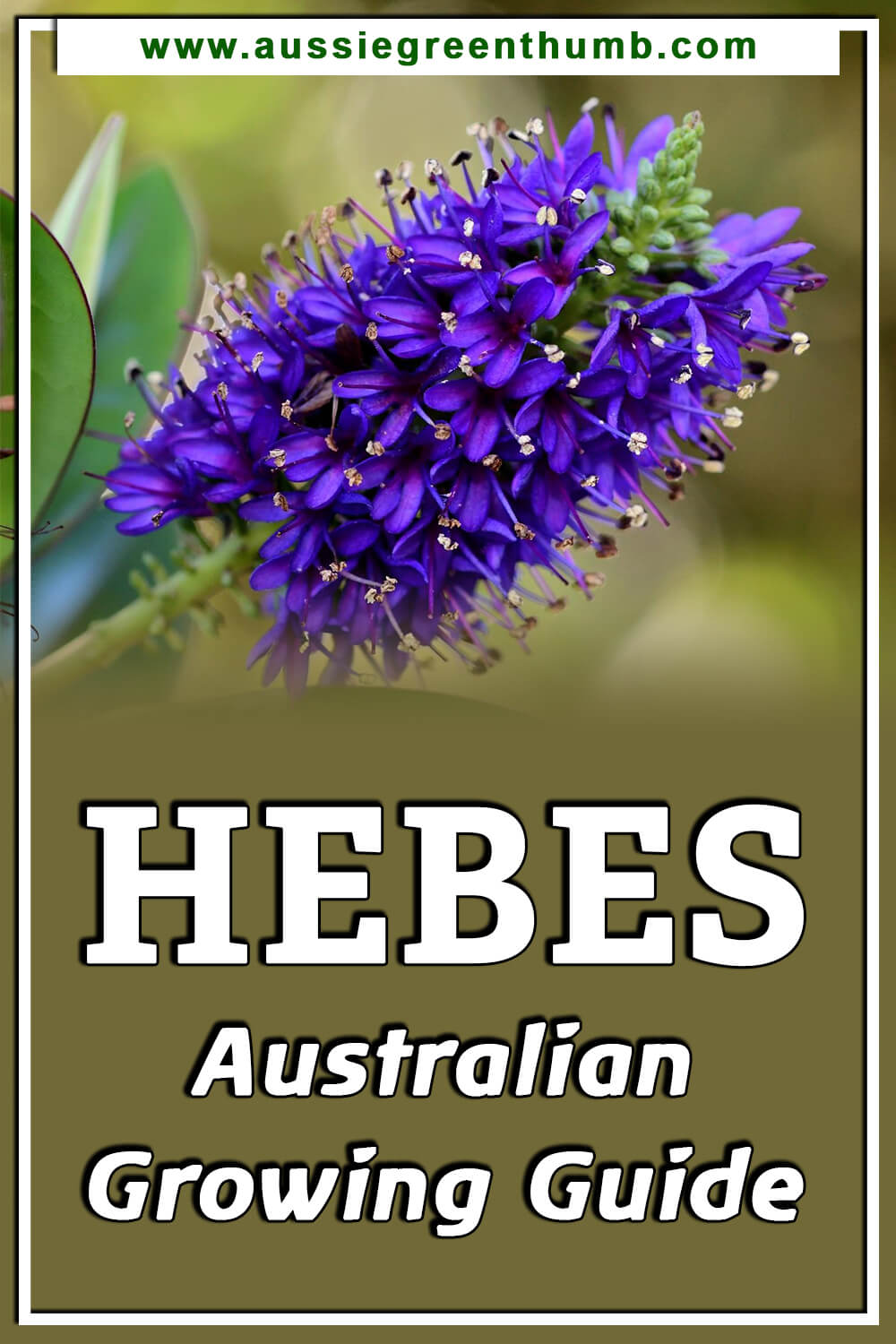
Wrapping Up Our Hebes Growing Guide
Shrubby Veronica, a shrub that can deal with the harshness of a mountain slope, and just as effortlessly, look beautiful in your garden. Talk about versatility!
Hebes bloom generously and also attract butterflies, so not only will you have divine flowers to enjoy, your shrub will invite other pretty garden visitors too. With their ability to be compact and work in any garden, you will enjoy nurturing this shrub to its best potential.
Growing a hebe is super easy, and you can propagate from cuttings with a good success rate. We’re quite taken with this shrubby New Zealand native, and are giving the hebe our green thumbs up!
Published on March 30, 2022 by Maisie Blevins
Last Updated on February 21, 2025





Fantastic article about looking after hebes. Everything well explained and answered all my queries. Thank you very much.
Hi Tania,
Thank you so much for your kind words! I’m happy you found the article helpful and that it answered all your questions. If you have any more questions, please don’t hesitate to reach out. Happy gardening!
Best regards,
Maisie Blevins